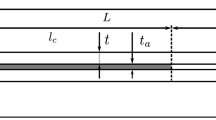Abstract
Mode II crack propagation along a bonded joint is investigated using newly proposed Inverse-End Loaded Split experimental configurations. This test configuration allows stable crack propagation all along the crack propagation path. The specimen compliance and strain energy release rate for the new experimental arrangement are derived. An experimental data reduction procedure, based on the effective crack length approach, is also proposed. Two series of experiments are performed to assess the stable nature of the crack propagation and data reduction scheme associated to this new experimental arrangement. In addition to stable crack growth, the experiment may prove his worthiness in the study of crack onset under mode II loading.













Similar content being viewed by others
References
Alderliesten RC (2009) Damage tolerance of bonded aircraft structures. Int J Fatigue 31:1024–1030
Alfredsson KS (2004) On the instantaneous energy release rate of the end-notch flexure adhesive joint specimen. Int J Solids Struct 41(16–17):4787–4807
Alfredsson KS, Stigh U (2012) Stability of beam-like fracture mechanics specimens. Eng Fract Mech 89:98–113
Ashcroft IA, Hughes DJ, Shaw SJ (2001) Mode I fracture of epoxy bonded composite joints: 1. Quasi-static loading. Int J Adhes Adhes 21(2):87–99
ASTM D1002-10—standard test method for apparent shear strength of single-lap-joint adhesively bonded metal specimens by tension loading (metal-to-metal)
ASTM D3163-2010—lap shear strength of adhesively bonded plastics
ASTM D5868-2010—lap shear adhesion for fiber reinforced plastics (FRP)
Bennati S, Colleluori M, Corigliano D, Valvo PS (2009) An enhanced beam-theory model of the asymmetric double cantilever beam (ADCB) test for composite laminates. Compos Sci Technol 69(11–12):1735–1745
Bing Q, Sun CT (2007) Effect of compressive transverse normal stress on mode II fracture toughness in polymeric composites. Int J Fract 145:89–97
Blackman BRK, Brunner AJ, Williams JG (2006) Mode II fracture testing of composites: a new look at an old problem. Eng Fract Mech 73(16):2443–2455
Budzik MK, Jumel J, Ben Salem N, Shanahan MER (2013) Instrumented end notched flexure—crack propagation and process zone monitoring. Part II: data reduction and experimental. Int J Solids Struct 50(2):310–319
Carlsson LA, Gillespie JW, Pipes RB (1986) On the analysis and design of the end notched flexure (ENF) specimen for mode II testing. J Compos Mater 20(6):594–604
Chai H, Mall S (1988) Design aspects of the end-notch adhesive joint specimen. Int J Fract 36:R3–R8
Jumel J, Budzik MK, Ben Salem N, Shanahan MER (2013) Instrumented end notched flexure—crack propagation and process zone monitoring. Part I: data reduction and experimental. Int J Solids Struct 50(2):310–319
Stutz S, Cugnoni J, Botsis J (2011) Studies of mode I delamination in monotonic and fatigue loading using FBG wavelength multiplexing and numerical analysis. Compos Sci Technol 71:443–449
Vanderkley PS (1981) Mode I–mode II delamination fracture toughness of a unidirectional graphite/epoxy composite. M.Sc. Dissertation, Texas A&M University
Wang H, Vu-Khanh T (1996) Use of end-loaded-split (ELS) test to study stable fracture behaviour of composites under mode II loading. Compos Struct 36(1):71–79
Author information
Authors and Affiliations
Corresponding author
Rights and permissions
About this article
Cite this article
Budzik, M.K., Jumel, J. Inverse End Loaded Split test configuration for stable mode II crack propagation in bonded joint: macroscopic analysis—effective crack length approach. Int J Fract 207, 27–39 (2017). https://doi.org/10.1007/s10704-017-0216-0
Received:
Accepted:
Published:
Issue Date:
DOI: https://doi.org/10.1007/s10704-017-0216-0




